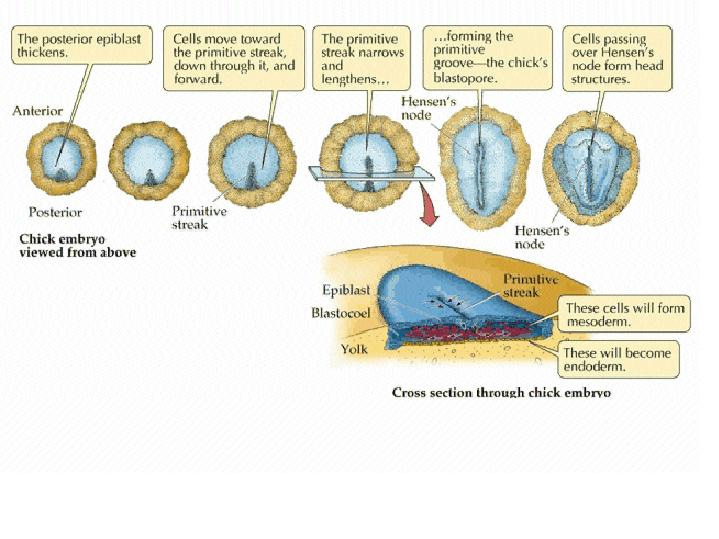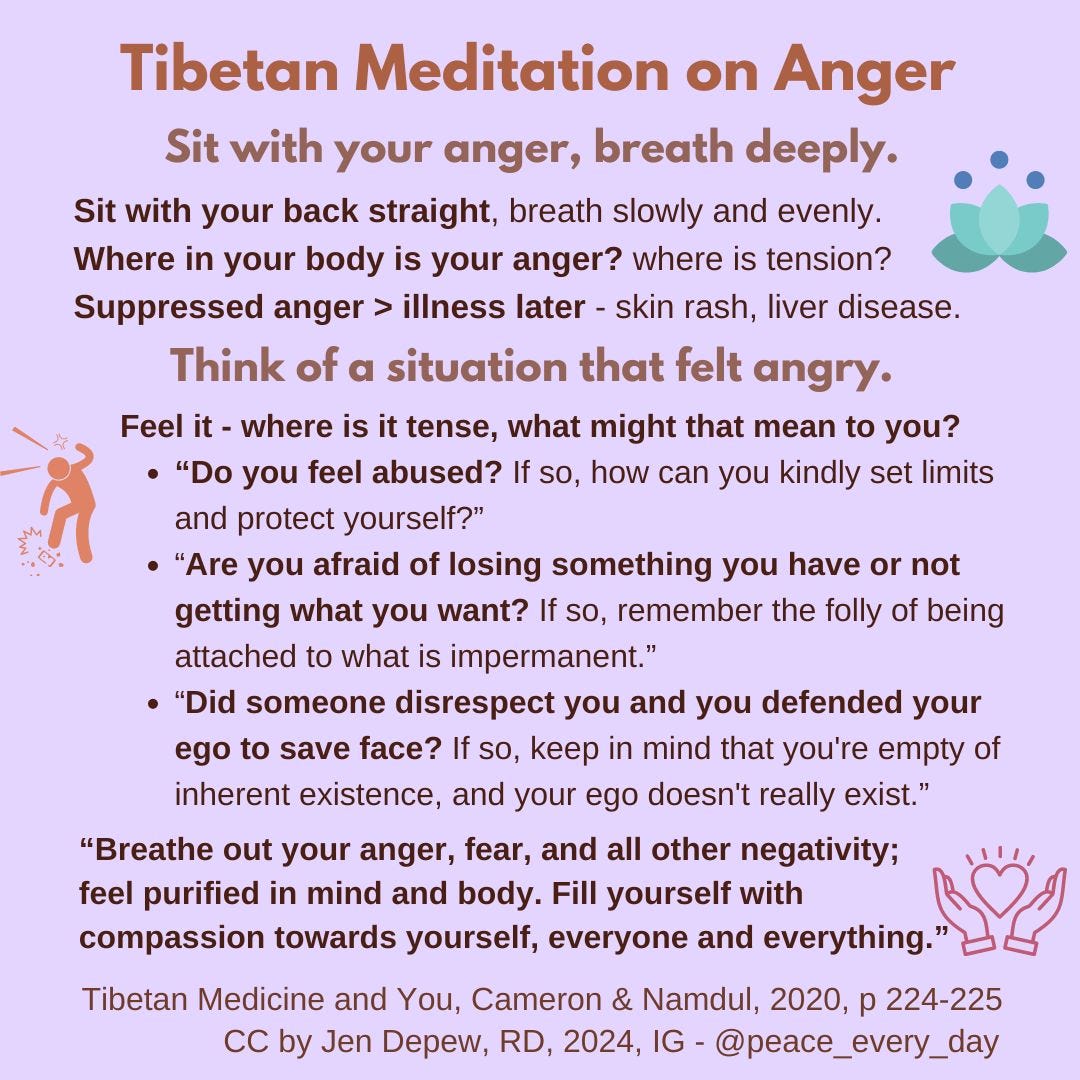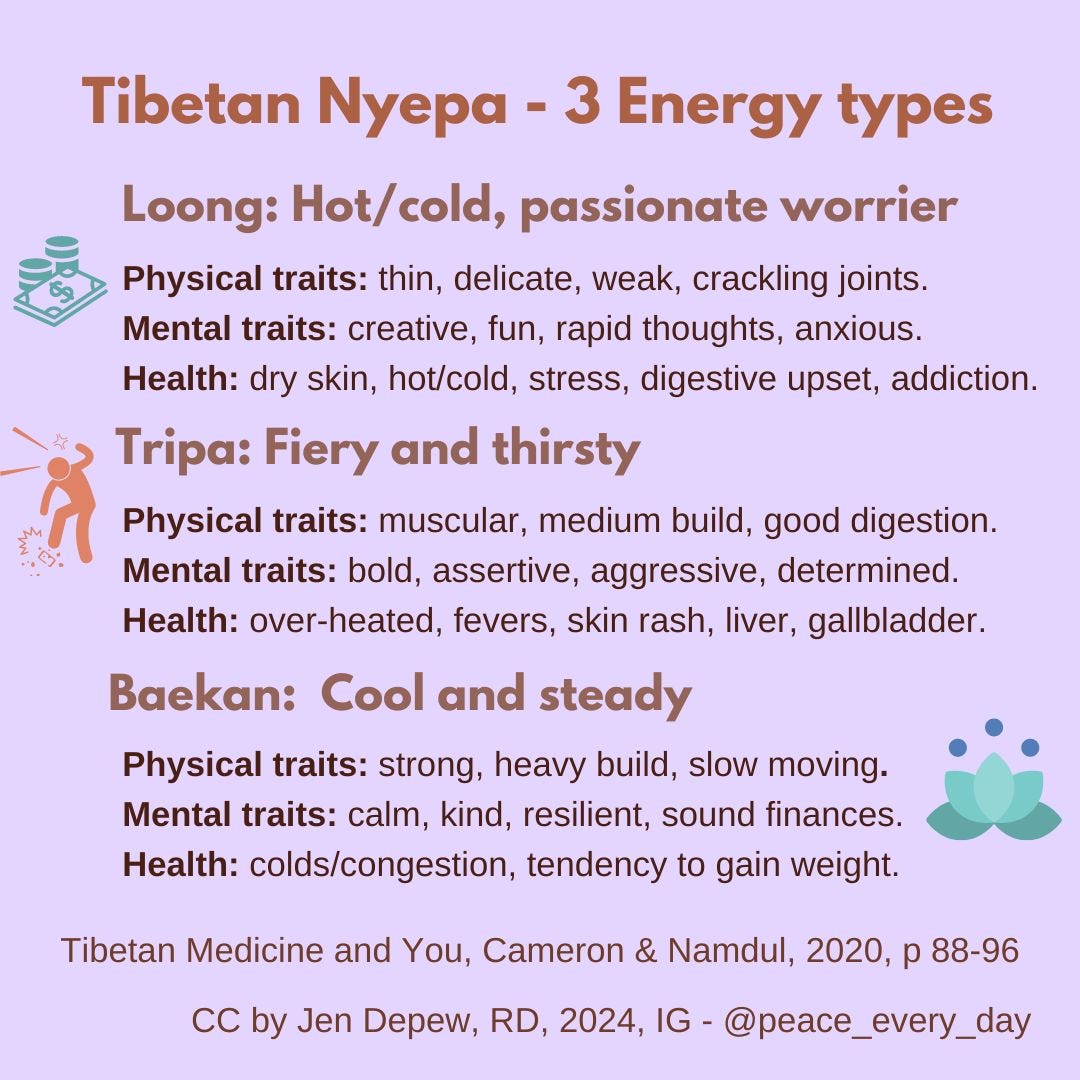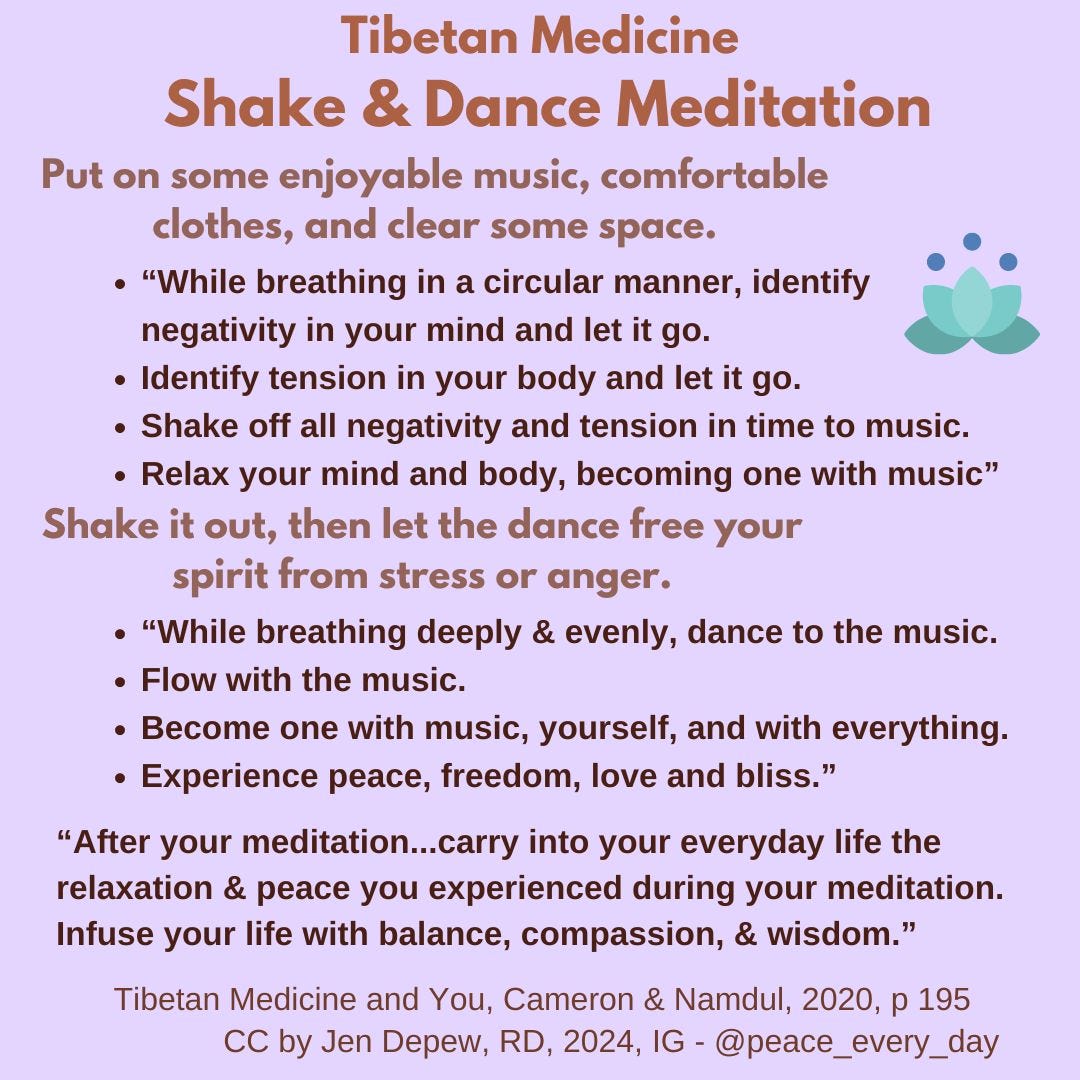Embryology, Tibetan Medicine, Stereotypes & Individual differences.
*I have a post in the works about magnesium, and embryology plays a part, so I am going to write about embryology first.
No one likes being stereotyped - lumped into a category as if there is nothing unique about you - yet we do tend to stereotype groups of people. It is a safety mechanism in part to try to figure out if this stranger might be trustworthy or dangerous - “Should I stay or should I go?” (The Clash, song)
The Clash song is written from a male’s perspective about a female who isn’t being clear in her signaling - is that flirting meant to lead to something more, or is it just teasing? The male in the song is abiding by ‘consent’ social expectations rather than being a risk to her. That doesn’t really have to do with embryology - where embryology comes in is in our human tendency to ‘group’ people by personality traits and other visual differences.
Many variations of personality typing occur around the world and the interesting thing is to look at the overlaps. In Tibetan Medicine and Ayurveda and in Western physiology, three basic body types with personality tendencies are described and the descriptions overlap more than they differ. Traditional Chinese Medicine has five types, but also describes three channels of energy within the spine similarly to Tibetan Medicine and similarly to the findings of Western physiology. And that is mind-blowing or should be in my opinion. Ancient peoples with acupuncture needles and good questioning, listening, and observation skills, managed to figure out the same things that Western medicine barely understands but was able to visualize with various scanners and measuring devices.
So where to turn for health guidance? The people who have known a lot about health for over 2000 years or the people who have a lot of machinery but little success with ‘curing’ most conditions.
The embryology - three personality and body types are described by several disciplines/groups as being something we all have some of but that we tend to not have in exactly equal amounts - not quite balanced amounts. And in the embryo we see that in the very, very early, ‘hollow-ball-of-cells’ phase, the ball of cells folds in on itself in a way that ends up with three distinct layers of ‘membrane’. The ectoderm is the exterior layer, the mesoderm is the middle layer, and the endoderm is the interior layer. Largely the ectoderm becomes our skin, and the endoderm becomes our digestive system and the mesoderm becomes our muscles and skeleton.
"It is not birth, marriage, or death, but gastrulation, which is truly the most important time in your life."
Lewis Wolpert (1986) (biology.kenyon.edu/courses/biol114/Chap14)
The balance or imbalance that leads to some standard variations in human build and personality, seems to be based on the three layers formed during “gastrulation”, and whether the developing baby had more or less of each layer that was formed during the in-folding process.
“During gastrulation, cell movements result in a massive reorganization of the embryo from a simple spherical ball of cells, the blastula, into a multi-layered organism. During gastrulation, many of the cells at or near the surface of the embryo move to a new, more interior location.
The primary germ layers (endoderm, mesoderm, and ectoderm) are formed and organized in their proper locations during gastrulation. Endoderm, the most internal germ layer, forms the lining of the gut and other internal organs. Ectoderm, the most exterior germ layer, forms skin, brain, the nervous system, and other external tissues. Mesoderm, the the middle germ layer, forms muscle, the skeletal system, and the circulatory system.” (biology.kenyon.edu/courses/biol114/Chap14)

Personality and physical types from different cultures seem to involve the germ layers of gastrulation.
The different cultures have different words for these three types, but the descriptions overlap quite a bit.
In Tibetan Medicine the three types are called our Nyepa which work together to give us mental and physical health.
People with more of the Loong energy might be thin, with weak joints, tend to fluctuate between being too hot or too cold, and may be worriers susceptible to stress, digestive upset and addictions. Those tendencies may indicate a person that got a bit more of the ectoderm layer during their very early development.
More Tripa energy is associated with a muscular, medium build and good digestion. Becoming over-heated may be a tendency, and anger and aggressiveness may occur instead of the more positive tendency towards assertiveness. Anger and liver disease may be a risk of imbalance in this energy type. These tendencies may indicate a person that got more of the mesoderm layer in their very early fetal development.
Baekan energy tends towards calm, good planning, kind, and a strong, heavy build that tends towards overweight. Respiratory conditions and congestion tend to be a risk. These tendencies may indicate a person whose endoderm layer received a bit more cells during early fetal development.
When we go out of balance energetically, we are also going out of balance emotionally and physically. Tibetan Medicine and Traditional Chinese Medicine focus on the emotional tendencies seen with different chronic conditions in a way that Western medicine has only slightly touched on with “Type A” personalities being more at risk for heart disease. Type A workers are the ones who push themselves and rarely take time off.
In Ayurveda (medical approach used in India), the energy types are called doshas instead of nyepa and the three types are called Vata, Pitta and Kapha.
“The three Doshas (Tridoshas) are Vata, Pitta and Kapha. Their psychological correlates which play a role in the functioning and behavior of humans is the Trigunas—Sattva, Rajas and Tamas.” (Shilpa and Venkatesha Murthy, 2011)
Ayurveda has a combination of five elements making up the three doshas:
“One of the basic tenets of Ayurveda is that man is a microcosm of the very world that he inhabits. This implies explicitly that whatever man is made up of, the world too is made up of those same things or elements, but of different combinations and degrees. Here, by elements is meant the five Mahabhutas—that is, Akasa, Vayu, Tejas, Ap and Prithvi. The earth and man are made up of these five elements. In fact, Ayurveda postulates that all living beings on the earth, including the non-living too, are made up of these same five elements in varying degrees, specific to each form, matter and species, and according to a predetermined ratio that cannot be changed. These five elements combine with each other to form the three humors of Vata, Pitta and Kapha (also called as the Tridoshas in unison) which is the cornerstone of Ayurvedic philosophy.” (Shilpa and Venkatesha Murthy, 2011)
The exactness of ancient theories is not as important in my opinion as the patterns we are seeing among the ancient theories, some of which we also see in Western discoveries about physiology. Both Tibetan Medicine and Ayurveda describe the three types as having seven variations - some people can be a bit more of two of the categories rather than being more of one than the other two. In other words - people have basic similarities, but also vary. Ayurveda takes those a bit farther into 16 personality types, which is a match to the popular Western Myers-Briggs personality typing. (themyersbriggs.com)
The Ayurvedic Body Types and their Characteristics, (Vata, Pitta, Kapha), (Youtube)
In my opinion or theory, Vata would be roughly similar to the Loong nyepa and maybe more ectoderm cells in fetal development. Pitta is roughly similar to the Tripa nyepa and more mesoderm cells, and Kapha is similar to the Baekan nyepa and more endoderm cells. The difference may be in function or distribution of the layers too, rather than being a simple difference in cell count - I don’t know the details. I just look at patterns.
People vary, but also are similar, and that pattern seems to occur around the world in many cultures. We like to try to understand each other better, because it can lead to more success in life versus having more troubles in life form misunderstanding each other’s intentions or motivators.
Tibetan medicine, TCM, and Ayurveda all stress that we have all of the traits, it is just a question of balance - how much of each is being expressed? The more recent Western developed theory of 24 Character Strengths, also emphasizes that we have them all, just we may tend to have more or less skill in the different categories.
Simpler systems with fewer categories may be less descriptive of differences, but may be more useful to the average person due to the simplicity. Gretchen Rubin is the bestselling author of “The Happiness Project” and more recently published “The Four Tendencies - The Indispensable Personality Profiles That Reveal How to Make Your Life Better (and other People’s Lives Better, Too)” (2017). She developed her categories based on observations and questioning of herself and others. The four categories are based on whether we tend to meet external or internal obligations more readily, or both, or neither. That is looking at personality rather than other physical characteristics, and yet it overlaps somewhat with the Five Elements of TCM.
Of Gretchen Rubin’s four tendencies, the “Obliger” meets external obligations more easily than taking care of their own needs - this tends to match the “Earth” element and motherhood - the nurturing caregiver is a need for our group survival but often is disrespected or over-worked.
The “Upholder” tends to meet both external and internal obligations well and may end up in positions of leadership or running a small business. The Upholders are self-starters, where the Obliger may need a manager to give them deadlines and external accountability/obligations. {Small area of potential bias - Gretchen considers herself an Upholder and admires the category, while also sharing that rigidity of rule following can be a weakness.} In TCM the “Metal” element or the “Wood” element may become a little too perfect, too inflexible, too organized or workaholic.
The “Rebel” in Gretchen Rubin’s book tends to not meet external or internal obligations well - this is the person who seems to self-sabotage and not do things that would be helpful for their lives. In TCM the “Fire” element is a pretty good match.
The “Questioner” tends to not meet external obligations well - there are always more questions to ask and information to be considered before accepting that the external request is worth obliging. This might overlap somewhat with the “Water” element personality type in TCM.
If we look at Gretchen Rubin’s theory from the perspective of the parenting styles that a baby may have experienced, then the “Obliger” likely had authoritarian parents who never taught the child how to follow their own internal needs because the authoritarian parent or school always, always, told the child what to do, how to do it, when it was okay to do it, etc.. That child never learned that meeting their own needs was something that people “do”. That child’s internal paradigm might be that people only “do what they are told to do or what they are allowed to do”.
Parents with better attachment skills would be more likely to raise an “Upholder” child who learned that their internal needs are separate from their parent’s and are worthy and valuable to respond to in addition to trying to meet the external expectations of their parents.
Children who couldn’t trust their parents to have consistent reactions may become “Anxious-Avoidant” and have difficulty trusting anyone as an adult.
These core values learned from life experience as a little person can stick with us throughout our adult lives. However, with practice, change slowly can occur. Gretchen Rubin makes the point in her book a few times, that these tendencies are kind of ‘fixed’ and it is easier to work around them than to think you can change your inner tendencies. I would think that is kind of true, but that also it is a nocebo suggesting that a Fixed mindset is our only possibility. We can have a Growth mindset which accepts that change can occur with practice and effort. The author/s of the 24 Character Strengths stresses that growth is possible - these are skills that we can improve rather than someone having been handed “a bad personality or a good personality” early in life and we are just stuck with that for ever after. (Character strengths, post 1, post 2)
Nutrient deficiencies and imbalance can have huge impact on what might seem like personality traits - until the underlying issue is resolved and the ‘personality trait’ goes away. Physical tendencies based on fetal development could be leading to a few specific nutrient imbalances which then lead to a certain pattern of mental traits too. If the body is wasting magnesium and not absorbing it well, then certain mood and illness patterns might follow.
Nature and nurture are both important for raising a healthy and happy child. So are listening and teaching children to listen and respond to their own body’s needs. Raising a child with too many rules is likely just as bad as raising a child with no rules, but one child might be a better taxpayer than the other child, later in life.
Embryology was my point -
Nature: what a child is made of prior to birth; which wandered into
Nurture: what a child experiences in life after birth.
How we nurture a pregnant person is also affecting the embryo though - her stress will increase stress for the fetus and babies can be born with a whole lot of inflammation instead of health. In more traditional, older cultures, a pregnant person would be treated a little special rather than being expected to go to a 9 to 5 job everyday.
Our personalities may not be fixed at birth, or during gastrulation, but some strong tendencies might be set in place prior to birth, and then our experiences in life also affect our lifelong tendencies.
A lack of cannabinoids during toddlerhood will/can set up a person who is more anxious throughout life, but so can early childhood trauma.
Ancient cultures have wisdom that Western cultures lost or never had. That is my opinion, but it seems evidence-based.

Tibetan Medicine recommends shaking and dancing yourself to a better state of mind and health. I think we should listen. ;-)
Disclaimer This information is being provided for educational purposes within the guidelines of Fair Use and is not intended to provide individual health guidance.
Reference List
Chapter 14. Gastrulation and Neurulation, Kenyon College, (biology.kenyon.edu/courses/biol114/Chap14)
(Shilpa and Venkatesha Murthy, 2011) Shilpa S, Venkatesha Murthy CG. Understanding personality from Ayurvedic perspective for psychological assessment: A case. Ayu. 2011 Jan;32(1):12-9. doi: 10.4103/0974-8520.85716. PMID: 22131752; PMCID: PMC3215408. https://www.ncbi.nlm.nih.gov/pmc/articles/PMC3215408/








Who would have thought that the Clash could have a connection to embryology?
one of my favorite of your subs for sure !!! my bandmate is a certified tcm practitioner , acupuncturist and naturopath , i will certainly forward this article to him and ps thanks for the musical interlude jj from nj